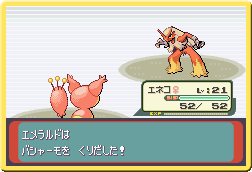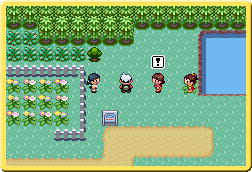|
|

|
BATTLE SYSTEM
|

|
INTERACTION
|

|
ORIGINALITY
|

|
STORY
|

|
MUSIC & SOUND
|

|
VISUALS
|

|
CHALLENGE
|
Easy to Hard
|
COMPLETION TIME
|
35+ Hrs.
|
|
OVERALL
3.0/5
|
Rating definitions
|
|
|
Pokemon, the Series That Wouldn't Die, seems destined to hold the
world championship title for most remakes ever. Pokemon Emerald, a remake
of Pokemon Ruby and Pokemon Sapphire so subtle it could almost be considered a re-release,
continues this trend by adding in a handful of new features and battle areas.
As with most Pokemon games, people who don't like the series will find little
or nothing to change their minds, whereas those who do will most certainly
not want to miss it. Perhaps the people who benefit most from Pokemon
Emerald, however, are the die-hard of the die-hard Pokemon gamers - the ones who not
only know what EVs and IVs are, but have those respective values of their
Pokemon party memorized.
Nintendo, it seems, has finally decided on a bit of transparency where
the deepest mechanics of this franchise is concerned. Everyone already knows
the basics of a Pokemon game - pull together a party of six wild critters
from a nearly limitless selection, teach 'em to fight and run around beating
the brains out of various Gym Leaders, all in a bid to claim the title of
League Champion for yourself. What most people don't know is that in addition
to the six stats the game actually shows you, the Pokemon games have a selection
of numbers associated with those stats that determine their actual values
- EVs, which are gained by fighting other Pokemon, and IVs, which are determined
when you receive the critter. In the past, these two values have remained
hidden, to the point where Nintendo wouldn't even acknowledge they existed
until their discovery by cheat device-using trainers. In Emerald, Nintendo
not only hints at their existence, but provides ways of determining and
manipulating these invisible stats, albeit in a way that would make absolutely
no sense if you didn't already know what you were doing. This, in addition
to an easier to manage method of teaching some of the rarer moves in Pokemon-dom,
should have advanced trainers drooling in anticipation.
Alongside these improvements in gameplay comes a slight improvement
in interfacing. The PC system used to store Pokemon not currently in your
party can now also quickly and easily handle their equipped items. The font
of Ruby and Sapphire, widely acknowledged as The Font That Ate Chicago, is
now a much more manageable size. Other than that, though, the game shows
remarkably little difference from R/S.
Audio has long been a sticking point with Pokemon, particularly
sound effects. Even in Pokemon Colosseum for the GameCube, the creatures
sound blatantly electronic. Dragons and worms alike sound more like trucks
or static than actual living creatures. The music, while hardly a delight
for the ears, is reasonably well done.
 The new animations don't really add much to the game.
The new animations don't really add much to the game.
|
|
Being a remake is never good for the originality, and this is where
Pokemon Emerald really suffers. Not only are there no new creatures and very little in the way of new plot, but for the first 75% of the
game, there's very little in the way of new game, period. The fact is that until the player gets
past the Elite Four - where most normal gamers would stop - Pokemon Emerald
is as close to being the same game as Pokemon Ruby and Sapphire as makes
no difference. There are a few differences in plot stemming from the fact
that the player now has to deal with both Team Aqua and Team Magma at the
same time. There is only one new dungeon, however, and while there is a new
pseudo-cinema near the end, the path the player takes through the game is
largely unchanged. In the end, while the changes do help the plot some, it's
too little too late. Its attempt at explaining moral ambiguity to a young
crowd falls largely on its face, and beyond that rather lackluster and unambitious
goal, the story has no point.
Visually, Pokemon Emerald is a bit better than Ruby and Sapphire, but not by much. The font change does help
with some readability issues R/S had, but one of the biggest selling points
of Emerald around pre-release time was the inclusion of animations for each
of the three hundred fifty-odd creatures in the game. Unfortunately, these
amount to little more than two frames of animation per creature and perhaps
a little sprite rotation. The overall design of the Pokemon themselves remains
quite good, bright and colorful with some interesting use of line and shapes;
However, Emerald does little to distinguish itself from the other games in
the series, visually.
 Emerald increases the frequency of 2v2 battles.
Emerald increases the frequency of 2v2 battles.
|
|
Being produced as it is for a fairly young crowd, Pokemon Emerald is
not what you'd call fiendishly difficult. At least for the first part of
the game. One of the other major additions to Pokemon Emerald is a large
optional section called the Battle Frontier. Sort of like a new series of
Gyms, the Frontier offers a wide variety of challenges akin to an entire
new region to battle in. The challenges range from the normal, such as the
Battle Dome, in which three-member parties fight elimination tournament style,
to the weird, like the Battle Factory, where your Pokemon will fight without
benefit of a trainer to command them. Some of these challenges, such as the
aforementioned Factory, are based almost entirely on luck, making them potentially
insanely frustrating. Others practically require you to breed Pokemon specifically
to defeat them, a time-consuming and tedious affair. Add to this a Frontier
Brain - basically a Gym Leader with insanely powerful Pokemon at his command
- and you have a recipe for deranged levels of challenge. As with nearly
all Pokemon games, the time required to finish the game depends entirely
upon what you mean by "finished".
Pokemon has a lot going for it. A deceptively complex battle system,
a wide variety of potential parties leading to a great focus on individual
customization, and a broad and fanatical community of gamers, for a start.
However, it's also got a lot working against it; it's been going on for a while,
and it's beginning to show its age. As the series grows, it seems to lose
more and more of its originality, which is never a good sign. Though it is
highly unlikely that Nintendo would consider canceling the series - they
might as well point a Howitzer at their foot - they need to do something
to reinvigorate it. While Pokemon Emerald may make the die-hard fans happy,
it's going to take a bit more to keep everyone else interested.
Review Archives
|









